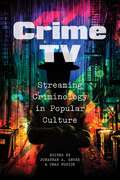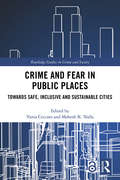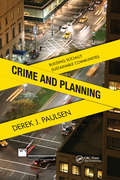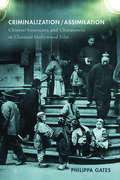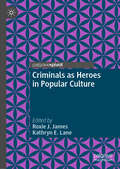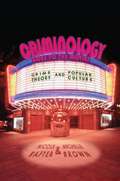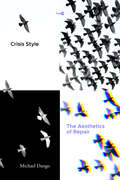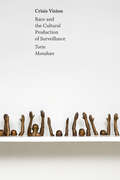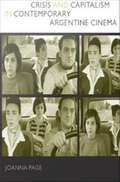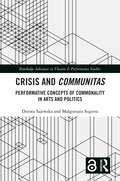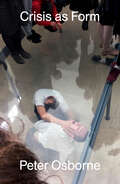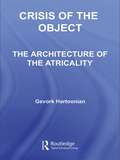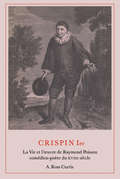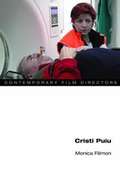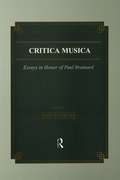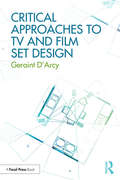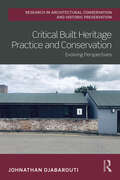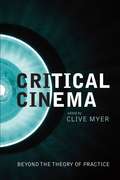- Table View
- List View
Crime TV: Streaming Criminology in Popular Culture
by Ben Jones Eduardo MendietaFrom Game of Thrones to Breaking Bad, the key theories and concepts in criminal justice are explained through the lens of televisionIn Crime TV, Jonathan A. Grubb and Chad Posick bring together an eminent group of scholars to show us the ways in which crime—and the broader criminal justice system—are depicted on television. From Breaking Bad and Westworld to Mr. Robot and Homeland, this volume highlights how popular culture frames our understanding of crime, criminological theory, and the nature of justice through modern entertainment. Featuring leading criminologists, Crime TV makes the key concepts and analytical tools of criminology as engaging as possible for students and interested readers. Contributors tackle an array of exciting topics and shows, taking a fresh look at feminist criminology on The Handmaid’s Tale, psychopathy on The Fall, the importance of social bonds on 13 Reasons Why, radical social change on The Walking Dead, and the politics of punishment on Game of Thrones. Crime TV offers a fresh and exciting approach to understanding the essential concepts in criminology and criminal justice and how theories of crime circulate in popular culture.
Crime and Fear in Public Places: Towards Safe, Inclusive and Sustainable Cities (Routledge Studies in Crime and Society)
by Vania Ceccato Mahesh K. NallaThe Open Access version of this book, available at https://www.taylorfrancis.com/books/9780429352775 has been made available under a Creative Commons Attribution-Non Commercial-No Derivatives 4.0 license. No city environment reflects the meaning of urban life better than a public place. A public place, whatever its nature—a park, a mall, a train platform or a street corner—is where people pass by, meet each other and at times become a victim of crime. With this book, we submit that crime and safety in public places are not issues that can be easily dealt with within the boundaries of a single discipline. The book aims to illustrate the complexity of patterns of crime and fear in public places with examples of studies on these topics contextualized in different cities and countries around the world. This is achieved by tackling five cross-cutting themes: the nature of the city’s environment as a backdrop for crime and fear; the dynamics of individuals’ daily routines and their transit safety; the safety perceptions experienced by those who are most in fear in public places; the metrics of crime and fear; and, finally, examples of current practices in promoting safety. All these original chapters contribute to our quest for safer, more inclusive, resilient, equitable and sustainable cities and human settlements aligned to the Global 2030 Agenda for Sustainable Development.
Crime and Planning: Building Socially Sustainable Communities
by Ph.D., Derek PaulsenThe form and layout of a built environment has a significant influence on crime by creating opportunities for it and, in turn, shaping community crime patterns. Effective urban planners and designers will consider crime when making planning and design decisions. A co-publication with the American Planning Association, Crime and Planning:
Crime in the Art and Antiquities World: Illegal Trafficking in Cultural Property
by Stefano Manacorda Duncan ChappellThe theft, trafficking, and falsification of cultural property and cultural heritage objects are crimes of a particularly complex nature, which often have international ramifications and significant economic consequences. Organized criminal groups of various types and origins are involved in these illegal acts. The book Crime in the Art and Antiquities World has contributions both from researchers specializing in the illegal trafficking of art, and representatives of international institutions involved with prevention and detection of cultural property-related crimes, such as Interpol and UNESCO. This work is a unique and useful reference for scholars and private and public bodies alike. This innovative volume also includes an Appendix of the existing legal texts, i.e. international treaties, conventions, and resolutions, which have not previously been available in a single volume. As anyone who has undertaken research or study relating to the protection of cultural heritage discovers one of the frustrations encountered is the absence of ready access to the multi- various international instruments which exist in the field. Since the end of the Second World War these instruments have proliferated, first in response to increasing recognition of the need for concerted multinational action to give better protection to cultural property during armed conflict as well as ensuring the repatriation of cultural property looted during such conflict. Thus the international community agreed in 1954 upon a Convention for the Protection of Cultural Property in the Event of Armed Conflict. That Convention, typically referred to as the Hague Convention of 1954, is now to be found reproduced in the Appendix to this book (Appendix I) together with 25 other important and diverse documents that we believe represent a core of the essential international sources of reference in this subject area. In presenting these documents in one place we hope that readers will now experience less frustration while having the benefit of supplementing their understanding and interpretation of the various instruments by referring to individual chapters in the book dealing with a particular issue or topic. For example, Chapter 9 by Mathew Bogdanos provides some specific and at times rather depressing descriptions of the application in the field of the Hague Convention 1954, and its Protocols (Appendices II and III), to the armed conflict in Iraq. Reference may also be had to the resolution of the UN Security Council in May 2003 (Appendix VI) urging Member States to take appropriate steps to facilitate the safe return of looted Iraqi cultural property taken from the Iraq National Museum, the National Library and other locations in Iraq. Despite such pleas the international antiquities market seems to have continued to trade such looted property in a largely unfettered manner, as demonstrated by Neil Brodie in Chapter 7. Fittingly, as referred to in the Preface to this book, the last document contained in the Appendix (Appendix 26) is the "Charter of Courmayeur", formulated at a ground breaking international workshop on the protection of cultural property conducted by the International Scientific and Professional Advisory Council (ISPAC) to the United Nations Crime Prevention and Criminal Justice Program in Courmayeur, Italy, in June 1992. The Charter makes mention of many of the instruments contained in the Appendix while also foreshadowing many of the developments which have taken place in the ensuing two decades designed to combat illicit trafficking in cultural property through international collaboration and action in the arena of crime prevention and criminal justice.
Criminalization/Assimilation: Chinese/Americans and Chinatowns in Classical Hollywood Film
by Philippa GatesCriminalization/Assimilation traces how Classical Hollywood films constructed America’s image of Chinese Americans from their criminalization as unwanted immigrants to their eventual acceptance when assimilated citizens, exploiting both America’s yellow peril fears about Chinese immigration and its fascination with Chinatowns. Philippa Gates examines Hollywood’s responses to social issues in Chinatown communities, primarily immigration, racism, drug trafficking, and prostitution, as well as the impact of industry factors including the Production Code and star system on the treatment of those subjects. Looking at over 200 films, Gates reveals the variety of racial representations within American film in the first half of the twentieth century and brings to light not only lost and forgotten films but also the contributions of Asian American actors whose presence onscreen offered important alternatives to Hollywood’s yellowface fabrications of Chinese identity and a resistance to Hollywood’s Orientalist narratives.
Criminals as Heroes in Popular Culture
by Kathryn E. Lane Roxie J. JamesThis book delves into humanity’s compulsive need to valorize criminals. The criminal hero is a seductive figure, and audiences get a rather scopophilic pleasure in watching people behave badly. This book offers an analysis of the varied and vexing definitions of hero, criminal, and criminal heroes both historically and culturally. This book also examines the global presence, gendered complications, and gentle juxtapositions in criminal hero figures such as: Robin Hood, Breaking Bad, American Gods, American Vandal, Kabir, Plunkett and Macleane, Martha Stewart, Mary Read, Anne Bonny, Ocean’s 11, Ocean’s Eleven, and Let The Bullets Fly.
Criminology Goes to the Movies: Crime Theory and Popular Culture
by Nicole Rafter Michelle BrownA &“deftly written and absorbing&” look at how films reflect concepts in criminology and affect our perceptions of criminal behavior (Richard Rosenfeld, coauthor of Crime and the American Dream). From Psycho to Double Indemnity to Thelma & Louise, Nicole Rafter and Michelle Brown show that criminological theory is produced not only in the academy through scholarly research, but also in popular culture through film. Criminology Goes to the Movies connects with ways in which students are already thinking criminologically through engagements with popular culture, encouraging them to use the everyday world as a vehicle for theorizing and understanding both crime and perceptions of criminality. The first work to bring a systematic and sophisticated criminological perspective to bear on crime films, Rafter and Brown&’s book provides a fresh way of looking at cinema using the concepts and analytical tools of criminology to uncover previously unnoticed meanings in film, ultimately making the study of criminological theory more engaging and effective for students while simultaneously demonstrating how theories of crime circulate in our mass-mediated worlds. With chapters focusing on films including Do the Right Thing, Capturing the Friedmans, and more, the result is an illuminating new way of seeing movies and a delightful way of learning about criminology.
Cripple Creek District: Last of Colorado's Gold Booms
by Cripple Creek District Museum Jan MackellThe Cripple Creek District, on the back of Pikes Peak in central Colorado, first found fame through Bob Womack, the cowboy who publicized his knowledge of gold in the high country and drew thousands to the area. Gold fever allowed the region to flourish, while strikes, fires, and economic hardships threatened the district's survival. The dwindling population's fortitude, plus innovative ideas to boost the economy, carried the city from a struggling gold-miners' paradise to a favored tourist spot.
Crisis Style: The Aesthetics of Repair (Post*45)
by Michael DangoIn this expansive and provocative new work, Michael Dango theorizes how aesthetic style manages crisis—and why taking crisis seriously means taking aesthetics seriously. Detoxing, filtering, bingeing, and ghosting: these are four actions that have come to define how people deal with the stress of living in a world that seems in permanent crisis. As Dango argues, they can also be used to describe contemporary art and literature. Employing what he calls "promiscuous archives," Dango traverses media and re-shuffles literary and art historical genealogies to make his case. The book discusses social media filters alongside the minimalism of Donald Judd and La Monte Young and the television shows The West Wing and True Detective. It reflects on the modernist cuisine of Ferran Adrià and the fashion design of Issey Miyake. And, it dissects writing by Barbara Browning, William S. Burroughs, Raymond Carver, Mark Danielewski, Jennifer Egan, Tao Lin, David Mitchell, Joyce Carol Oates, Mary Robison, and Zadie Smith. Unpacking how the styles of these works detox, filter, binge, or ghost their worlds, Crisis Style is at once a taxonomy of contemporary cultural production and a theorization of action in a world always in need of repair. Ultimately, Dango presents a compelling argument for why we need aesthetic theory to understand what we're doing in our world today.
Crisis TV: Hispanic Television Narratives after 2008 (SUNY series in Latin American and Iberian Thought and Culture)
by María del Carmen Caña Jiménez; Vinodh VenkateshCrisis TV addresses the motif of crisis that has come to dominate contemporary Hispanic televisual production since 2008 and the onset of the global financial crisis. In almost unprecedented fashion, the global economy came to a standstill, reshaping both geopolitical organizations and, more importantly, the lives of billions across the globe. The Great Recession, sociopolitical instabilities, the rise of extremist political parties and governments, and a worldwide pandemic have resulted in a mode of crisis that pervades contemporary television fiction. 2008 also marks a revolution in television, as local and global streaming services began to gain market share and even overtake traditional over-the-air transmission. The essays in Crisis TV identify and analyze the narrative tropes and aesthetic qualities of Hispanic television post-2008 to understand how different regions and genres have negotiated these intersecting crises and changing dynamics in production, dissemination, and consumption.
Crisis Vision: Race and the Cultural Production of Surveillance (Errantries)
by Torin MonahanIn Crisis Vision, Torin Monahan explores how artists confront the racializing dimensions of contemporary surveillance. He focuses on artists ranging from Kai Wiedenhöfer, Paolo Cirio, and Hank Willis Thomas to Claudia Rankine and Dread Scott, who engage with what he calls crisis vision—the regimes of racializing surveillance that position black and brown bodies as targets for police and state violence. Many artists, Monahan contends, remain invested in frameworks that privilege transparency, universality, and individual responsibility in ways that often occlude racial difference. Other artists, however, disrupt crisis vision by confronting white supremacy and destabilizing hierarchies through the performance of opacity. Whether fostering a recognition of a shared responsibility and complicity for the violence of crisis vision or critiquing how vulnerable groups are constructed and treated globally, these artists emphasize ethical relations between strangers and ask viewers to question their own place within unjust social orders.
Crisis and Capitalism in Contemporary Argentine Cinema
by Joanna PageThere has been a significant surge in recent Argentine cinema, with an explosion in the number of films made in the country since the mid-1990s. Many of these productions have been highly acclaimed by critics in Argentina and elsewhere. What makes this boom all the more extraordinary is its coinciding with a period of severe economic crisis and civil unrest in the nation. Offering the first in-depth English-language study of Argentine fiction films of the late twentieth century and early twenty-first, Joanna Page explains how these productions have registered Argentina's experience of capitalism, neoliberalism, and economic crisis. In different ways, the films selected for discussion testify to the social consequences of growing unemployment, rising crime, marginalization, and the expansion of the informal economy. Page focuses particularly on films associated with New Argentine Cinema, but she also discusses highly experimental films and genre movies that borrow from the conventions of crime thrillers, Westerns, and film noir. She analyzes films that have received wide international recognition alongside others that have rarely been shown outside Argentina. What unites all the films she examines is their attention to shifts in subjectivity provoked by political or economic conditions and events. Page emphasizes the paradoxes arising from the circulation of Argentine films within the same global economy they so often critique, and she argues that while Argentine cinema has been intent on narrating the collapse of the nation-state, it has also contributed to the nation's reconstruction. She brings the films into dialogue with a broader range of issues in contemporary film criticism, including the role of national and transnational film studies, theories of subjectivity and spectatorship, and the relationship between private and public spheres.
Crisis and Communitas: Performative Concepts of Commonality in Arts and Politics (Routledge Advances in Theatre & Performance Studies)
by Małgorzata Sugiera Dorota SajewskaThis book is a critical, transdisciplinary examination of a broad range of philosophical ideas, theoretical concepts, and artistic projects of community in the 20th and 21st century in the context of global/local social and political changes. This volume opens new vitas by focusing on carefully selected instances of multipronged crises in which existing concepts of commonality are questioned, reformulated, or even speculatively designed with a (better) future in view. As many authors of this volume argue, in the face of today’s unprecedented global ecological and economic challenges speculative design is of utmost importance as it can foster alternative, unthought-of forms of connectivity that go far beyond progressivist narratives of nation, corporation, and nuclear family. Focusing on the situations of upheaval, both historical and fabulated, the collection not only examines how multipronged crises trigger antagonisms between egalitarian forms of communitas and the normative concept of the nation (and other normative forms of communities) as a community that separates and excludes. It also looks closely at philosophical and artistic projects that strive to go beyond the dichotomies and typically extrapolated utopias, envisaging new political economies, ways of living and alternative relational structures. It will be of great interest to students and scholars in performance studies, cultural studies, political studies, media studies, postcolonial and decolonial studies, critical anthropology.
Crisis as Form
by Peter OsborneHow does contemporary art best respond to social crisis? Through reflection on its own crisis of formCriticism of contemporary art is split by an opposition between activism and the critical function of form. Yet the deeper, more subterranean terms of art-judgment are largely neglected on both sides. These essays combine a re-examination of the terms of judgement of contemporary art with critical interpretations of individual works and exhibitions by Luis Camnitzer, Marcel Duchamp, Matias Faldbakken, Anne Imhof and Cady Noland. The book moves from philosophical issues, via the lingering shadows of medium-specificity (in photography and art music), and the changing states of museums, to analyses of the peculiar ways that works of art relate to time.To give artistic form to crisis, it is suggested, one needs to understand contemporary art&’s own constitutive crisis of form.
Crisis of the Object: The Architecture of Theatricality
by Gevork HartoonianLooking back over the twentieth century, Hartoonian discusses the work of three major architects: Peter Eisenman, Frank Gehry and Bernard Tschumi, in reference to their theoretical positions and historicizes present architecture in the context of the ongoing secularization of the myths surrounding the traditions of nineteenth century architecture in general, and, in particular, Gottfried Semper's discourse on the tectonic. Providing a valuable contribution to the current debates surrounding architectural history and theory, this passionately written book makes valuable reading for any architect.
Crispien Ier: La Vie et l'œuvre de Raymond Poisson comédien-poète du XVIIe siècle
by A. Ross CurtisRaymond Poisson, a contemporary of Molière, was the leading comic actor with the troupe of the Hôtel de Bourgogne and later at the Comédie Française during the first five years of its existence. He popularized one of the French stage's best-loved stock characters, the impudent servant Crispin, while finding time to supply his troupe with short comedies in which he himself starred. This study is thoroughly documented and reflects the author's detailed knowledge of, and interest in, the period. It establishes Poisson's place in theatrical history, and illuminates a whole tradition in French theatre in the seventeenth century.
Criss-Cross: The Making of Hitchcock's Dazzling, Subversive Masterpiece Strangers on a Train
by Stephen RebelloTake a deep dive into the shadows and light of one of the most subversive, corrosively funny, and beloved suspense thriller masterworks as author Stephen Rebello unravels for the very first time the tense and drama-filled story of the making Alfred Hitchcock's Strangers on a Train. As entertaining as it is to watch Strangers on a Train, so too is the previously untold backstory that packs all the suspense, drama, and twists of a thriller. After all, what are the hallmarks of a great Hitchcock movie? A larger-than-life, complex cast of characters, each with something to prove, lose, or hide. Check. Tremendous risk, outsized conflict, and emotion as those men and women confront challenges off the set. Check. Feuds, deceptions, unlikely alliances, and double-crosses. Check. Coming off a 5-year-string of flops, Alfred Hitchcock gambled big on adapting Patricia Highsmith's debut novel, which critics called &“preposterous&” and &“unconvincing," in addition to &“unsavory,&” and &“sick&” (1950s code words for &“gay&” and &“perverted&”). Each step of the production was fraught with battles, but Hitchcock masterfully stayed two steps ahead of his opponents as he fought to bring his vision to life. Strangers on a Train became not only a creative high-water mark and box-office smash for Hitchcock, but also kicked off his unmatched decade of classics including Dial M for Murder, Rear Window, Vertigo, North by Northwest, and Psycho. Richly documented, meticulously researched, and stylishly written, Criss-Cross is more than an authoritative film book. It is a portrait of an especially politically paranoid, misogynistic, and homophobic era in America, a time of dramatic transition in the entertainment industry, and a day of reckoning for Alfred Hitchcock and a few other talents with whom he made a dark, resonant, and prescient work of art.
Cristi Puiu (Contemporary Film Directors)
by Monica FilimonCristi Puiu's black comedy The Death of Mr. Lazarescu announced the arrival of the New Romanian Cinema as a force on the film world stage. As critics and festival audiences embraced the new movement, Puiu emerged as its lodestar and critical voice. Monica Filimon explores the works of an artist dedicated to truth not as an abstract concept, but as the ephemeral revelation of the fuller, ungraspable world beyond the screen. Puiu's innovative use of the handheld camera as an observer and his reliance on austere, restricted narration highlight the very limits of human understanding, guiding the viewer's intellectual and emotional sensibilities to the reality that has been left unfilmed. Filimon examines the director's ethics of epiphany not only in relation to the collective and personal histories that have triggered it, but also in dialogue with the films, texts, and filmmakers that have shaped it.
Critica Musica: Essays in Honour of Paul Brainard (Musicology)
by J. KnowlesThis is Volume 18 of eighteen in a book series on Musicology. Originally published in 1996, this is a collection of essays in honor or Paul Brainard. Critica Musica-thinking critically about music-is at the heart of Paul Brainard's long career, and of his legacy to his students, colleagues, and friends. As a scholar, performer, and teacher, Professor Brainard has embodied a thorough, meticulous, and reasoned approach to music and scholarship that has set a high standard for all who have come in contact with him.
Critical Acting Pedagogy: Intersectional Approaches (Routledge Advances in Theatre & Performance Studies)
by Lisa Peck Evi StamatiouCritical Acting Pedagogy: Intersectional Approaches invites readers to think about pedagogy in actor training as a research field in its own right: to sit with the complex challenges, risks, and rewards of the acting studio; to recognise the shared vulnerability, courage, and love that defines our field and underpins our practices. This collection of chapters, from a diverse group of acting teachers at different points in their careers, working in conservatoires and universities, illuminates current developments in decolonising studios to foreground multiple and intersecting identities in the pedagogic exchange. In acknowledging how their positionality affects their practices and materials, 20 acting teachers from the United Kingdom, the United States, Europe, and Oceania offer practical tools for the social justice acting classroom, with rich insights for developing critical acting pedagogies. Authors test and develop research approaches, drawn from social sciences, to tackle dominant ideologies in organisation, curriculum, and methodologies of actor training.This collection frames current efforts to promote equality, diversity, and inclusivity in the studio. It contributes to the collective movement to improve current educational practice in acting, prioritising well-being, and centering the student experience.
Critical Approaches to TV and Film Set Design
by Geraint D'ArcyThe analysis of scenic design in film and television is often neglected, with visual design elements relegated to part of the mise-en-scène in cinema or simply as "wallpaper" in television. Critical Approaches to TV and Film Set Design positions itself from the audience perspective to explore how we watch TV and film, and how set design enhances and influences the viewing experience. By using semiotics, history and narratology and adding concepts drawn from art, architecture and theatre, Geraint D’Arcy reworks the key concepts of set design. Looking at the impact of production design on how the viewer reads film and television, these updated theories can be applied more flexibly and extensively in academic criticism. D’Arcy creates a new theoretical approach, representing a significant expansion of the field and filling the remaining gaps. This book is ideal for anyone interested in understanding how we can read and interpret design in film and television, and should be the primary point of reference for those studying TV and film set design.
Critical Architecture
by Jonathan Hill Jane Rendell Mark Dorrian Murray FraserCritical Architecture examines the relationship between critical practice in architecture and architectural criticism. Placing architecture in an interdisciplinary context, the book explores architectural criticism with reference to modes of criticism in other disciplines - specifically art criticism - and considers how critical practice in architecture operates through a number of different modes: buildings, drawings and texts. With forty essays by an international cast of leading architectural academics, this accessible single source text on the topical subject of architectural criticism is ideal for undergraduate as well as post graduate study.
Critical Built Heritage Practice and Conservation: Evolving Perspectives (Routledge Research in Architectural Conservation and Historic Preservation)
by Johnathan DjabaroutiCritical Built Heritage Practice and Conservation - Evolving Perspectives supports an alternative point of departure for engaging with the historic built environment, by critically questioning the legitimacy of dominant conservation concepts and methods that are often taken for granted within building conservation, architecture, and adaptive reuse. The meaning of heritage is changing. From pastness to presentness, from preservation to participation, and from tangible to intangible, heritage is increasingly understood as a dynamic, social, and intangible process across many disciplines. Consequently, the role and remit of the built heritage practitioner – and in particular the architectural conservationist – is becoming progressively complex and in need of a critical gaze. Is restoration really a falsehood from beginning to end? Should the condition of existing materials determine the conservation method? Is authenticity really an inherent quality within old buildings? By engaging with a critical interpretation of heritage, this book makes space for practitioners to consider the evolution of their own role within a rapidly changing context of built heritage practice. Reinforced by a shift in emphasis from materials to meanings, a ‘socio-material outlook’ is proposed which champions an enhanced focus on intangible heritage within the built heritage sector, whilst still acknowledging the physical condition of old buildings is a priority for many stakeholders. This book has been written with practitioners, students, and educators of architectural conservation in mind – although will also be of relevance to the broader built heritage industry; as well as academics, researchers, and heritage students with a passion for contemporary dialogues in heritage studies.
Critical Cinema: Beyond the Theory of Practice
by Ed. Myer CliveCritical Cinema: Beyond the Theory of Practice purges the obstructive line between the making of and the theorising on film, uniting theory and practice in order to move beyond the commercial confines of Hollywood. Opening with an introduction by Bill Nichols, one of the world's leading writers on nonfiction film, this volume features contributions by such prominent authors as Noel Burch, Laura Mulvey, Peter Wollen, Brian Winston and Patrick Fuery. Seminal filmmakers such as Peter Greenaway and Mike Figgis also contribute to the debate, making this book a critical text for students, academics, and independent filmmakers as well as for any reader interested in new perspectives on culture and film.
Critical Cinema: Beyond the Theory of Practice
by Clive MyerCritical Cinema: Beyond the Theory of Practice purges the obstructive line between the making of and the theorising on film, uniting theory and practice in order to move beyond the commercial confines of Hollywood. Opening with an introduction by Bill Nichols, one of the world's leading writers on nonfiction film, this volume features contributions by such prominent authors as Noel Burch, Laura Mulvey, Peter Wollen, Brian Winston and Patrick Fuery. Seminal filmmakers such as Peter Greenaway and Mike Figgis also contribute to the debate, making this book a critical text for students, academics, and independent filmmakers as well as for any reader interested in new perspectives on culture and film.
